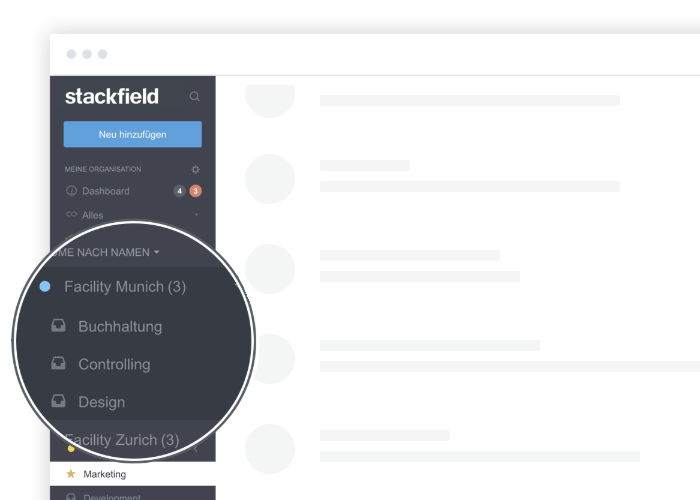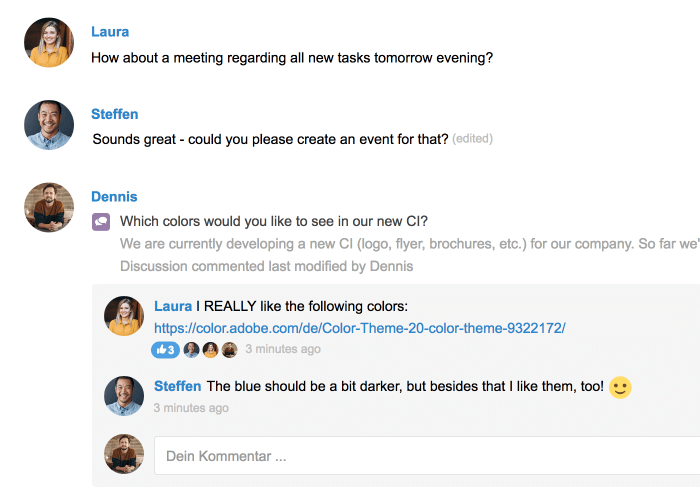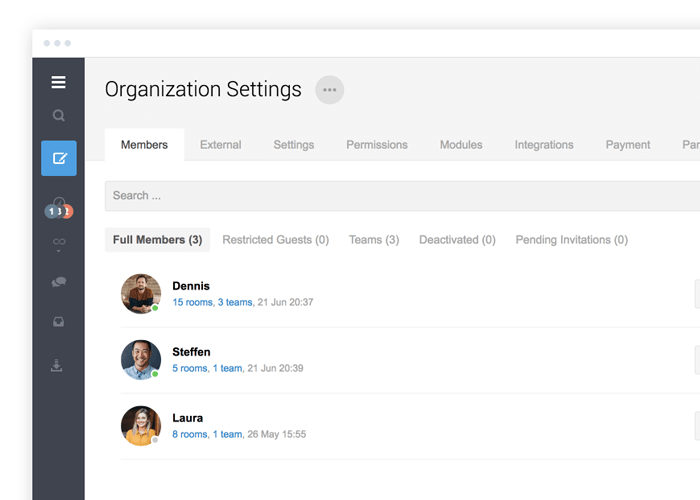A tool that has accompanied us for so long. Slowly, on the quit, it says goodbye. With regard to internal communication, it has almost disappeared - the email. But are we really sad about that?
Do you remember your first email sent - the feeling of excitement when you pressed the "send" button for the first time and the hint of fascination that came with the first answer? It’s probably been a few years since then. Today, when you open your mailbox early in the morning, feelings are quite different. Little wonder, as some of us receive and answer more than 100 emails every day, and not all of them are even relevant. This takes, if nothing else, time and nerves.
Many companies rely on alternative tools by now and little by little, they abolish emails from their daily office life. Why the email evolved into a productivity killer and slowly but surely withdraws from our offices? We can name several reasons for this. Some publications already talk about the "death of the email". But is a complete renunciation possible at all?
"I’ll just check my emails real quick"
For many, clicking on the inbox opening button is the first item on the agenda when they arrive at the office in the morning. Because this non-binding communication method is regarded convenient and easy to use, email has become THE medium decades ago. Almost everyone uses it, whether privately or on business, even though it is often easier and more effective to talk directly, personally or over the phone.
136 unread emails - when minutes turn into hours and the email into a stress factor
The email has revolutionized the world of work and now it has such high significance that it is used to exchange information for all concerns. Customer queries, spam emails, company newsletters, messages from business partners, employees, casual agents – and also the colleague joins in asking for the lunch time plans. Somewhere in between there are a couple of incorrectly addressed messages. Oh, and there is this one: "I ask for urgent feedback. Mrs. Jordan has already sent you an email." Wait, where is Mrs. Jordan’s email?
It is some kind of tsunami that sweeps over us every morning when we click on the mailbox. In many cases, the “I’ll just check the emails real quick" turns into an hours-long struggle with messages we read, filter, search, forward and answer with queries. The actual tasks need to be squeezed in somehow.
Stories from email hell
1. The confusing mailbox becomes a black hole for information
Even email threads over more than five messages can become unmanageable. However, fifteen messages on a topic that hold (or ought to hold) the design guidelines for the upcoming presentation are likely to become true time-wasters. With good luck, the necessary information can be found through the search function quite quickly, but otherwise there is nothing left to do but to fight through the email jungle. The mailbox evolves into a black hole that somehow absorbs all information without system and order.
2. Emails leads to dependencies and reduces the flow of information
A big problem that comes with working with emails is also the dependency we go into. So where is Jordan’s email and how do I contact her to inquire about it? It seems like the task cannot be done without Mrs. Jordan’s input, so it has to be postponed for now. If entire groups are involved, a vicious circle develops, because the missing response of just one person can paralyze the work progress of everyone else. Add to that the uncertainty about whether your own email has already been read or even arrived.
3. Email chaos emerges with the turnover of employees
Many companies are still trying to manage projects - often with multiple participants - via email. The difficulties that arise from this become quite obvious when employees fluctuate.
At what point is the project? Who works on what? What special features have to be considered? If all the important information is distributed in the various mailboxes of colleagues, gathering information for new employees can be quite exhausting.
Messages that contain important information must be transferred individually. But even if all information has been gathered, work processes are not really apparent. Likewise, there is a high chance to forget something important.
Also, it gets inconvenient when employees are absent due to illness or if they are leaving the company. Information in emails is then no longer visible, which is why those mails must be forwarded and explained in advance.
Lack of transparency as a trigger for stress and extra hours
It is quite obvious that the factors mentioned above - the dependencies, the confusion, the information deficit - correlate and favor each other. All these problems, however, result from a single circumstance that – in times of the fast-paced digital world - makes the email seem to be obsolete: its high lack of transparency.
In order to guarantee optimal work processes, all people involved must have easy access to relevant data at all times. In fact, this quality does not exist in correspondence via mail. The inboxes of the participants are isolated from each other and so is the information contained therein.
The lack of important information not only favors a reduced productivity, but also fosters stress and not uncommonly, the constant waiting and enforced procrastination results in an excess of unnecessary extra hours. This will neither please employees nor employers.
From Email to Social Collaboration - Companies in Transition
More and more companies are certainly confident that the time has come to say goodbye to emails in daily business. And that makes sense, especially in terms of internal communication. Instant messaging services and cloud-based collaboration platforms have become more common, because they re-create transparency, that was formerly eliminated by email.
WhatsApp for Business – good or bad idea?
The instant messaging service WhatsApp is widely used as a communication medium in the business environment but it does present some serious problems. The exchange of messages in WhatsApp happens to be either 1: 1 or in group chats. The latter mainly supports the exchange of information in small teams. The parallel exchange on several topics, however, is very difficult, since the chat is merely a chronological continuity of messages. Connections are therefore not maintained and relevant content is easily lost.
Therefore, WhatsApp can only be used as an additional tool for quick exchange because of its restriction to simple chats, but is not suitable for general business collaboration. Although it is possible to send image, sound and document files, these are not linked to content by any means.
Furthermore, the questionable handling of the data sent - especially with regard to the GDPR – makes the use of it problematic. One must consider that former employees continue to have access to messages that were sent until that person actually left the company and - to be more exact - until he or she left the group chat.
How does Stackfield solve problems in corporate communications?

Unlike the correspondence via email, the collaboration software keeps relevant information readily accessible to all participants as it is provided centrally.
Stackfields goal is to solve these problems resulting from unmanageable email traffic and maximize business productivity. Data security always takes top priority.
The platform is based on various data rooms, which can be used as required for the communication within individual teams or departments, or simply divided into different theme rooms. These data rooms are the central collaboration platform for all members, giving everyone access to all relevant data.
Thread-based communication - that's how Stackfield creates clarity

Stackfield’s communication and discussion module prevents confusing message histories, such as those found in WhatsApp or in the email inbox. The team chat provides room for all communication within a team, with direct comments and file attachments. Messages are no longer read multiple and extensive discussions are outsourced in the same module, which is why the team chat does not lose clarity. Relevant information is always on the spot as all information is being effectively linked to the task and appointment manager.
Independent and transparent - this is how Stackfields users work

The central provision of all news, files and documents reduces the dependencies of other employees enormously, because various questions become superfluous with a quick look in Stackfield. For example, important background information can be stored in the documents or directly in the tasks. The documents module also makes it possible to work together on documents. Various labels show the processing status. Thus, the current version is always directly accessible and the waiting for the delivery of important documents or files has an end.
Simply change and adapt team structures - this is how Stackfield deals with fluctuation

If the structures within the team change - through short-term or long-term absence, new employees or internal employee transfers - information must be safely withdrawn from former employees and provided for new ones. With Stackfield being used as collaboration software, users can easily be added, removed, or deactivated at short notice. Thus, company-internal information never leaves the company and new team members have all the relevant content at hand. The granting of individual access rights opens up more possibilities in the provision of information, since particularly sensitive information can only be made accessible to certain users.
GDPR compliance – this is how Stackfield secures all sensitive data
All shared information is protected at Stackfield through a combination of AES and RSA algorithms, making it safe from third-party access. The end-to-end encryption ensures that all relevant content is being encrypted during the upload, decrypted during the download and that it also lies safely encrypted on Stackfield’s servers. These are located exclusively in German ISO 27001 certified data centers. These and other precautions make Stackfield a platform with security standards that go beyond GDPR requirements.
Many companies are replacing their internal communication channels with Stackfield. Project management in particular requires a tool that links functions well and clearly structures collaboration. Collaboration software solutions that fokus on project management increase productivity immensely. Unlike the correspondence via email, colleagues really work together actively - and in the case of Stackfield with a much higher level of data protection than ever before.
Banning email completely – is that possible?
The claim that the email will become extinct, cannot be confirmed at the current time. It depends on various factors whether and to what extent email is still used by companies. In exchange with customers and external business partners, it is often unavoidable to make use of the classic email. This is due to the fact that it is a universally used medium. For several decades, @, CC and BCC took hold for communications both in business and private environments. Individual communication partners do not have to be added into a special "email system" because they already use the email themselves. It won’t be possible to replace a medium, that is used extensively by almost every person worldwide, in the short term.
However, external communication with cloud-based tools still makes sense in some areas, especially when talking about large-scale projects and whenever data security is a major issue. In order to make joint projects transparent for important business partners and customers, they could be added as an external to the collaboration platform as well. And, as already pointed out, email is quite problematic when it comes to the security of sensitive data. Whether and when the email actually loses its right to exist, is still in the stars.